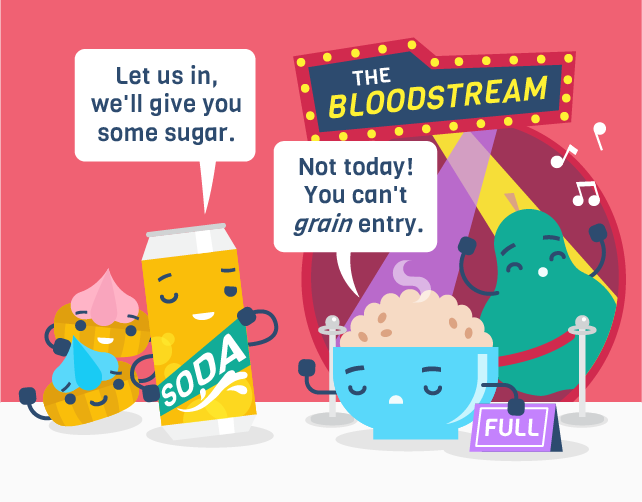-
No products in the cart.
Glycaemic Index 101: Glycaemic Load (GL) and Diabetes

6 Aug 2021
Written and Edited by: Nature’s Superfoods Team
Did you know that in Singapore, 1 out of 9 people aged 18 to 69 have Diabetes? That’s about 11.3% of our population, translating to more than 400,000 people! If left in a state of limbo, these numbers are expected to hit about 1 million by 2050. This helps us put things into perspective as to why there is a sudden sense of urgency to increase awareness and public health education in Singapore today regarding this matter.
Diabetes is a chronic illness where your blood sugar levels remain persistently high. This state is known as hyperglycaemia, and it occurs when your body is either producing too little insulin or unable to respond well to the insulin produced. Insulin is the hormone that converts the glucose in the blood to energy. There are three types of Diabetes, namely Type 1 Diabetes (insufficient insulin produced, often due to genetic predispositions), Type 2 Diabetes (insulin processing function is weakened) and Gestational Diabetes (occurs during pregnancy). In Singapore, Type 2 Diabetes is the most prevalent and occurs more frequently in people over the age of 40. Individuals who are overweight/obese, have a sedentary lifestyle, a family history of diabetes, high blood pressure and abnormal blood cholesterol have a higher risk of getting Type 2 Diabetes. The long-term complications of Type 2 Diabetes include Coronary Heart Disease, such as angina and heart attack, stroke, blindness and kidney failure. Hence, it is important to understand what affects blood glucose levels so that Type 2 Diabetes can be controlled or prevented. One of the ways to do so, is to look into the Glycaemic Index (GI) and Glycaemic Load (GL) of foods we consume since there is a direct correlation between the GI & GL and your blood sugar.
1. Glycaemic Index (GI)
We always hear the term glycaemic index (GI), but what exactly is GI? The GI is a scale from 1-100 that ranks carbohydrate foods on the impact it has on raising blood glucose levels after eating. Foods that have a high GI are known to result in a higher blood glucose level. Hence, individuals attempting to prevent the onset of Diabetes should consume foods with a lower glycaemic index to control blood glucose levels and aid weight loss efforts. It is important to consume fibre-packed wholegrains over refined carbs as fibre helps keep blood glucose levels within a healthy range. This is because fibre does not require insulin to be digested and hence, not recognised as carbohydrates by our digestive system – this prevents spikes in our blood sugar levels.
Glycaemic Index Food Chart
| Common Carbohydrates | GI | |
| Foods to consume more | Starchy staples. Quinoa, wholemeal pasta (boiled), rolled oats, oat bran, muesli, pearled barley Whole fruit. Apple, peach, pear, orange, kiwi, grapefruit, prune, berry, mango Vegetables. Green leafy vegetables, broccoli, tomato, onion, mushroom, carrot, pea, corn, mushroom, chili Beans, nuts & seeds. Legume, chickpea, lentil, soybean, baked bean, cashew nut, almond, peanut, pumpkin seeds, black chia seeds Snacks. popcorn (plain), dried fruits like goji berries, mulberries, apricots, and figs Beverage. Water | LOW 0 to 55 |
| Starchy staples. Brown rice, basmati rice, wholemeal bread, rye bread, pita bread, quick oats, couscous, pasta Whole fruit. Banana, grape, papaya, lychee Vegetables. Yam Snacks. Raisin, Figs Beverages. Fruit juice (no added sugar) | MEDIUM 56 to 69 | |
| Foods to consume less | Starchy staples. White rice, white bread, noodles, bagel, corn flakes, puffed rice, instant oats Whole fruit such as watermelon Vegetables. Potato (baked, boiled or mashed) Snacks. Pretzel, rice cake, cracker, dates Beverages. Honey, soft drinks | HIGH 70 to 100 |
Source: https://www.healthhub.sg/live-healthy/1330/the-gi-values-of-common-foods
2. Glycaemic Load (GL)
However, it is important to note that GI is not the only factor of concern for diabetic conditions. Portion size is also a crucial factor. The total amount of carbohydrate consumed is just as important as the GI of the food. For instance, a watermelon has a high GI but for the portion size we normally consume, which is one slice, it is considered low and safe for diabetic patients.
To better understand this, the glycaemic load (GL) was developed to describe the quality of carbohydrate (GI) and the quantity of carbohydrate in a food serving, meal or diet. It will then give you an estimate of how quickly a portion of a specific food type will raise the blood glucose levels. It can be calculated with the formula below:
Glycaemic Load of Food = (GI x amount (g) of available carbohydrate per serving) / 100
Studies have shown that in individuals with Type 2 Diabetes, lowering the GL is an effective method to improve glycaemic control. Lowering dietary GL can be achieved by decreasing intakes of moderate to high GI foods like potatoes and white rice while increasing the consumption of whole grains, nuts, legumes, fruit, and non-starchy vegetables.
To make it simpler to understand and to apply in our daily lives, we recommend plating your food using the guidelines from “My Healthy Plate”:
- Fill ½ of your plate with fruit and veggies
- Fill ¼ of your plate with wholegrains
- Fill ¼ of your plate with meat and other proteins
Therefore, whether looking for diabetic-friendly options to add to your shopping list or changing up your diet to prevent Diabetes, it’s crucial to look into both the GI and the GL of the foods, and be aware of the portion size of your daily meals.
References:
1. https://www.healthhub.sg/live-healthy/1832/the-truth-about-gi
2. https://www.healthhub.sg/live-healthy/1080/diabetes-detection–prevention
3. https://lpi.oregonstate.edu/mic/food-beverages/glycemic-index-glycemic-load
4. http://www.diabetes.org.sg/index.php

